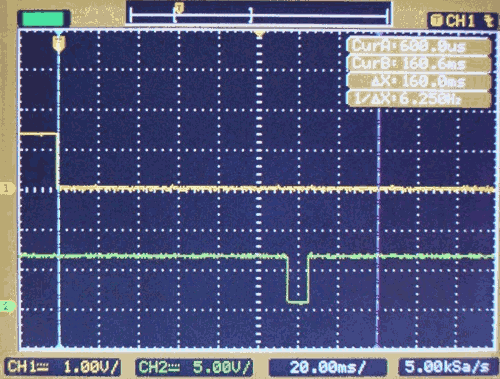The following are measurements of how well (or rather how bad) the Fuji cameras X-M1 and X-E2 synchronize
with themselves. What I mean by that is the difference between the delays of several shots.
This way it is possible to predict the sync of a stereo rig if there were second camera identical to those.
An oscilloscope is used to measure the delay between the Remote Shutter and the Hot Shoe flash trigger
of the cameras, which can be taken as a proxy for the actual photo shot.
X-M1:
The first image shows a GIF animation of several successive camera shots in the X-M1. The scope is triggered with the signal at
the top (CH1), which is taken from a remote trigger Fuji RR-90 connected to the micro-USB port of the camera from which it is
powered with 3V. The trigger shows down steps: from 3V to 1.3V (half press for focusing) and from 1.3V to 0V (full press).
The oscilloscope is triggered with the last.
The signal at the bottom (CH2) shows the flash trigger taken from the hot shoe. Hot shoe needs to be powered externally,
for which I used a 6V battery through a 39K resistor.
The test shows a trigger delay ~100ms (from full press to shot), and an apparent delay dispersion of ~30ms. Note however
that the hot-shoe as a width of 10ms, therefore the actual dispersion is 30-10= 20ms
This means that if we had another camera identical to this one, the synch error would be a random between -20ms and +20ms.

X-E2:
I used essentially the same procedure as the X-M1, but this time I made a video clip of the sequence of shots so it can be heard
the camera noise as it shoots.
The X-E2 can also be triggered with the RR-90 through the micro-USB port, but in addition it also features a dedicated connector
for a 2.5mm Stereo Jack, which is compatible with the Canon SLR remote (the X-M1 does not have this jack). For this test I used
a wireless release with the 2.5mm jack.
The signals are the same as the ones of X-M1, except the trigger switch signal which is taken from the 2.5mm jack, and you can notice
it is 2v instead of the 1.3v of the X-M1.
The delay dispersion is also essentially identical to the X-M1. As the last part of the video shows it is 24ms

Conclusion:
Pity that these otherwise great cameras behave so badly in regard to synch performance.
20ms error is really too much for stereo scenes of normal life. It is only good enough for slow moving scenes.
What is a "slow moving scene"? Here is my rule of thumb: something is "slow enough" when the stereo deviation induced by the synch
error is negligible in comparison with the normal stereo deviation, aka 3% of the width (from the famous 1/30 rule). Let us take as
a negligible disparity limit 1/100th of the canonical 3%: 0.03%. If this 0.03% disparity is produced by the 20ms synch error of a moving
object, means this object crosses the image from side to side in 100/0.03*20ms=67s (about 1 minute).
So 1 minute per width is the maximum speed you can shot with a 20ms synch error. Possibly passing clouds in a panorama shot, or
perhaps people instructed to remain quiet.
Having said that, note however the actual error is random, so in a series of shots most will have an error significantly less than 20ms, and
only a few will happen to show the worst case error.
This leads me to think a solution to build an usable stereo rig with a pair of these cameras: My oscilloscope tests show
you can know after the shot how much synch error happened. What if we made a little device (hopefully smaller than an oscilloscope:-)
that tell us the synch error after each shot? If we deemed the error too high, we would just repeat the shot until it chanced
a good enough synch.
Antonio Fernández Galaz